The Volvo BZL–SC Neustar City is an electric low-floor, three-door city bus jointly developed by SC Auto and Volvo Buses. The bus is built on the Volvo BZL Electric bus chassis and assembled in Singapore by local coachbuilder SC Auto.
The prototype bus was first unveiled on 17 November 2022 at a launch event held at SC Auto’s Senoko premises. This bus, which was intended for revenue service trials in Singapore, was exhibited with the Land Transport Authority’s (LTA) Lush Green livery and various other LTA-unique specifications. On 30 January 2023, this bus was registered as SG4007T with Tower Transit Singapore, which continues the SG4xxx-series bus registration numbers used for trial buses. Revenue service trials commenced on 26 March 2023 on Bus Service 990 and ended after 28 March 2024.
This is SC Auto’s first foray into the electric bus scene and comes at a time when the Land Transport Authority (LTA) is preparing to rapidly electrify the public bus fleet. Half of all public buses will be electric by 2030, which is about 3,000 buses.
Chassis Background
The Volvo BZL Electric is the first fully-electric bus chassis offered by Volvo, with two different component layouts designed for either single-deck or double-deck bus construction. It was officially unveiled in September 2021 and expanded on Volvo’s prior electric bus offering – the Volvo 7900e range – which was only available as an integral bus.
For the driveline, single-deck buses can be configured with a single or dual motor unit, with each motor rated at 200 kW (268 hp). The double-deck configuration is only available with the single-motor option. The electric motor(s) is coupled to a two-stage automated manual transmission, which according to Volvo, increases wheel torque at low speed and evens out current peaks, thus reducing energy usage and driveline wear.
As for charging options, the Volvo BZL Electric offers hardware interfaces for both the OppCharge opportunity charging platform and plug-in CCS charging at depots, both of which are currently used in Singapore (the prototype is configured for depot charging only). Its traction batteries use the Lithium NCA chemistry (lithium nickel cobalt aluminium oxide) in 94 kWh modules, and can be configured with between three and five modules, for an overall capacity of 282 kWh, 376 kWh or 470 kWh. These batteries are more energy dense than LFP (lithium iron phosphate) batteries commonly found in Singapore electric buses, thus contributing to reduced vehicle weight.
Apart from SC Auto, coachbuilders such as Volgren, MCV, and Express Coach Builders have also built on the Volvo BZL platform.
Volvo BZL–SC Neustar City
In Singapore, local coachbuilder SC Auto Industries partnered with Volvo Buses to develop the Volvo BZL–SC Neustar City, Singapore’s first indigenously-built range of bus bodies and buses. The bus was first unveiled on 17 November 2022 at a launch ceremony held at SC Auto’s premises in Senoko.
Before the launch event, the collaboration had been featured in a November 2022 Volvo press release and a featured piece in The Asian Buses magazine (Issue 31) published in Q3 2022.
SC Auto and Volvo designed the bus from scratch over a 12-month period, with a focus on safety and quality. On the manufacturing front, SC Auto is well-equipped to produce this new vehicle type, having had decades of experience in coachbuilding, and has dedicated one production line to the building of bus bodies on the Volvo BZL. In addition to high-tech production facilities, the company can manufacture fibre-reinforced plastic mouldings in-house, giving it self-sufficiency over importing moulded parts from third parties.
The traction batteries of the Volvo BZL–SC Neustar City are solely roof-mounted, which reduces cabin space occupied at floor level and frees up space in the passenger cabin. Furthermore, the bus incorporates design choices that facilitate easy component replacement in the field. SC Auto says the bodywork can also be supplied in both CKD and SKD forms.
Finally, the ‘SC Neustar City’ name builds on SC Auto’s success with the SC Neustar, an integral coach fully built in Singapore that launched in 2018.
As for the broader electric bus market in Singapore, the Land Transport Authority (LTA) is aiming to rapidly electrify the public bus fleet. Half of all public buses will be electric by 2030, which is about 3,000 buses. In the aftersales segment, a Volvo Buses press release in June 2022 describes the efforts of its local distributor (ComfortDelGro Engineering) in preparing its technicians to service these new vehicles.
Volvo and SC Auto initially planned to trial the bus on revenue service by the end of 2022, as announced during the launch ceremony.
Revenue service debut
On 30 January 2023, the prototype unit offered to LTA for revenue service trials was registered as SG4007T with Tower Transit Singapore, which continues the SG4xxx-series bus registration numbers used for trial buses.
Revenue service trials commenced on 26 March 2023 with the bus deployed on Bus Service 990. The bus was later redeployed to Feeder Service 282 from 9 October 2023 and can be also be deployed on an interline duty to Service 96 as well from 12 October 2023. The bus was also deployed on Service 947 for the first time on 9 February 2024 in an interline duty from Service 990. In addition, it was also deployed for the first time on Service 870 on 27 March 2024.
Trials ended after 28 March 2024, after one year in service. The bus was subsequently placed on a non-user lay-up status.
Post Trial
The bus was briefly taken out of lay-up (18–22 November 2024) to support the first Swedish state visit to Singapore, transporting Mr. Andreas Carlson, the Swedish Minister for Infrastructure and Housing. It was driven by a Tower Transit bus captain.
Technical Specifications
Basic technical specifications for the Volvo BZL – SC Neustar City offering include two motor options, and configurable battery capacity/charging modes.
| Volvo BZL – SC Neustar City | ||
| Dimensions | 12 m × 2.55 m × 3.2 m [Length × Width × Height], 5.95 m wheelbase Permitted GVW: 19,500 kg |
|
| Electric Driveline | Volvo EPT 402 (single motor option) – Maximum power/torque of 200 kW / 425 Nm – Continuous power of 167 kW – 2-speed automated manual transmission |
2× Volvo EPT 802 (dual motor option) – Maximum power/torque of 400 kW / 850 Nm – Continuous power of 334 kW – 2-speed automated manual transmission |
| Energy Storage | Lithium nickel cobalt aluminium oxide (NCA) traction batteries Up to 5 battery modules of 94 kWh each Option for CCS2 charging (150 kW max) or OppCharge charging (300 kW max) |
|
| Bodywork | SC Neustar City bodywork Ferritic stainless steel body structure; aluminium and composites for body panels and exterior parts |
|
| Third Door | 800 mm wide exit door behind the rear axle | |
Prototype unit specifications
Basic technical specifications for the Volvo BZL–SC Neustar City prototype unit are as follows:
| Volvo BZL – Prototype unit full specifications (SG4007T) | ||
| Vehicle Model | Volvo BZL | |
| Drivetrain | 2× Volvo EPT 802 electric motors – Maximum power/torque of 400 kW (200 kW × 2) / 850 Nm (425 Nm × 2) – Continuous power of 334 kW (167 kW × 2) – 2-speed automated manual transmission |
|
| Battery | Lithium nickel cobalt aluminium oxide (NCA) traction batteries 5× 94 kWh modules; total 470 kWh Charged via 90kW DC plug-in charger (CCS Type 2 connector) at Bulim Depot |
|
| Bodywork |
SC Neustar City bodywork Ferritic stainless steel body structure; aluminium and composites for body panels and exterior parts |
|
| EDS | Luminator ULTIMA Electronic Display Sign (EDS) Orange LED Matrix design. Luminator Basic driver controller. |
|
| PIDS | Luminator SMART Passenger Information Display System (PIDS) Interior-facing LCD screen (29”) and exterior-facing LCD screen (21.5”) Interior & Exterior Speakers |
|
| Driver Assistance | TNT Surveillance T-Guard – Forward collision warning system & lane departure warning (T-FA Front Alert Camera) – Side collision warning system (T-SA Side Alert Cameras) – Anti-Fatigue system (T-DA Driver Alert Camera) – Surround view camera system (T-A.I. 360°) |
|
| Passenger Capacity | 28 Seated + 53 Standing = 81 Passengers 2 Wheelchair Bays |
|
| Air-con | Denso LD9 | |
| Door Systems | SMC Transit – Inward-gliding leaf doors (Entrance) – Sliding plug doors (Exits) |
|
| Seats | Kiel Citos passenger seats Kiel Verso Rush Hour folding seat with electric lock (at wheelchair bay) |
|
| Additional Specifications | – USB Charging Ports (QC3.0 compatible) – TNT Surveillance T-APC passenger counters – Blue mood lighting – Stroller restraint system – Rear emergency exit hatch |
|
The passenger capacity was revised before entry into revenue service (previously 28 Seated + 61 Standing = 89 Passengers).
Based at Tower Transit’s Bulim Bus Depot, the bus is recharged via a 90 kW DC plug-in charger (CCS Type 2) originally installed for Yutong electric buses under an earlier LTA procurement for 60 electric buses. These chargers are supplied by Chinese electric power equipment supplier NARI. The Volvo BZL is rated for up to 150 kW of DC charging.
Exterior & Overview
The Volvo BZL – SC Neustar City bus is built in Singapore by SC Auto Industries. Volvo manufactures the Volvo BZL chassis in Sweden and supplies its lithium-ion batteries, while SC Auto manufactures and assembles the bus at its premises in Senoko.
The SC Neustar City bodywork uses a Ferritic stainless steel body structure, with aluminium and FRP composites for body panels and exterior parts. These materials offer high corrosion resistance and high yield strength that will last beyond the 17-year statutory lifespan of Singapore buses. Modular FRP panels also contribute to reduced downtime and repair costs in the event of an accident.
A key design feature aimed at the city bus market is the provision of a third door at the rear of the bus. In recent years, Singapore’s LTA has had a preference for 3-door buses to allow for quicker passenger ingress and egress, thus improving commuter flow.
Drivetrain & Charging
The prototype unit unveiled in November 2022 is of the dual-motor variant, with both motors mated to a two-speed automated gearbox. The Volvo BZL chassis featured at the launch ceremony is the single-motor variant.
Battery modules are located on the roof. This bus has a battery capacity of 470 kWh (across 5 battery modules) and is charged via plug-in CCS2 DC charging, at up to 150 kW. Alternative motor, battery and charging options can be specified depending on customer requirements; and if Oppcharge compatibility is desired, roof-mounted charging rails can also be fitted, which charge the bus at up to 300 kW.
Other roof-mounted components are the battery cooling module and the Denso LD9 air-conditioning system designed for electric buses.
Interior
The Volvo BZL–SC Neustar City boasts a spacious interior with 28 permanent seats. A full-low-floor design offers step-free access across the length of the bus.
This bus has a capacity for up to 81 passengers: 28 seated and 53 standing. This generous passenger capacity is attributed to having traction batteries on the roof, which maximises the cabin space for passengers. Blue mood lighting is also fitted to the bus cabin.
The bus is configured with three passenger doors. In addition to the front entrance and middle exit door, a second exit door is added at the very rear of the bus (behind the rear axle). This helps passengers exit the bus more quickly and encourages passengers to move towards the rear.
Passenger seats are supplied by Kiel from Germany (model: Kiel Citos). These seats are lightweight and shatterproof, and come upholstered in blue or red seat covers. Seats adjacent to the aisle have either a fixed, bow-type handle or a foldable armrest.
The three front wheel arch seats are mother-child seats which, in terms of seating capacity, count as one seat each. Two more foldable seats are integrated into the wheelchair backrest.
The bus provides a generous number of stanchion poles alongside the aisle, with one fitted to nearly every seat where space permits. Bus-stopping bells on these stanchion poles have areas around the bell also coated in yellow to aid with visual identification. Emergency hammers are located on pillars in-between windows.
Towards the rear of the bus and just after the rear axle, the aisle slants to the side to accommodate underfloor drivetrain components. The bus’ two motors, gearbox and driveshaft are located underneath the seats on the left. As a result, the right-side seats are single seats only.
The three-door bus design promotes the one-way flow of passengers towards the rear of the bus, allowing for faster boarding and alighting. Passengers may exit the bus from a third door located at the very rear of the vehicle.
The rear axle is also minimally protrusive into the bus cabin, and the change in height is minimal across the floorboard.
Wheelchair Accommodation
The Volvo BZL – SC Neustar City provides two wheelchair bays, both located opposite the exit door. Passengers-in-wheelchair (PIW) board and alight via a manual wheelchair ramp installed at the middle door.
Public buses in Singapore require two wheelchair bays in line with providing for an ageing population. They also offer more standing space, as well as room for unfolded prams.
Both wheelchair bays come fitted with USB charging ports and a dedicated PIW alighting bell. A foldable handlebar and a stroller restraint system are provided for wheelchair users and the securing of prams respectively.
For the benefit of PIWs, the foldable handlebar at each wheelchair bay can be manually deployed and stowed depending on the needs of the passenger. When stowed, the handlebar is locked in place using an indexing plunger.
The foldable seat, also supplied by Kiel, can be electronically locked, with an accompanying indicator lamp that indicates when it cannot be lowered.
Passenger Information Display System
The bus is installed with a Passenger Information Display System, with LCD screens and LED text displays facing inside and outside the bus. These are supplied by Luminator Technology Group.
While the full features of the PIDS have yet to be demonstrated in public, the following functionalities are based on other buses in Singapore fitted with the Luminator PIDS suite:
- LCD Display Panel — Interior roof-mounted
Shows the bus service number, destination, current time, next bus stop, and up to 3 subsequent bus stops, along with rail connections at those bus stops. - LCD Display Panel — Exterior-facing, beside entrance door
Shows the next few MRT/LRT stations served, and the number of bus stops to that MRT/LRT station - LED Text Display (x2) — Interior-facing, front and rear
Shows the bus service number, destination, and next bus stop
The PIDS is accompanied by voice announcements that are broadcasted to the bus cabin through interior speakers.
Driver’s Cab
The driver’s environment meets ISO 16121 standards, which contain requirements for an ergonomic and comfortable seating position to keep drivers in a good state of health for prolonged driving. This includes mounting positions of the driver’s seat, pedals, and carefully chosen steering allowance to enable drivers to sit comfortably.
Mounting points on the left side of the dashboard are intended for the installation of revenue service equipment, such as the Trapeze Common Fleet Management System (CFMS), NOBE fare collection system, and cash farebox.
SC Auto has also elected to locate many control switches on the right side of the driver rather than on the dashboard display. This includes cabin lighting, window heating, and door controls.
Located above the driver’s seat are CCTV monitors, the Electronic Display Sign controller, and a 360-degree surround-view camera monitor.
The prototype bus is fitted with an Advanced Driver Assistance System (ADAS) from TNT Surveillance. A Front Alert Camera provides forward collision warning, lane departure warning, distance monitoring & pedestrian detection functionalities. Side Alert Cameras, installed at the rear left and right sides of the bus, offer blind spot detection for pedestrians, cyclists, and other road users. Both systems are linked to two small display units on the right of the dashboard.
In addition, a 360-degree Surround View Camera system uses four external cameras on each side of the bus to compose a top-down view of the vehicle in real time. The system enhances the driver’s situational awareness on the roads and assists with blindspot monitoring.
Finally, the bus is also fitted with an Anti-Fatigue system, also supplied by TNT Surveillance, and is used to detect driver fatigue or abnormal behaviour. The system comes in the form of a small dash-mounted unit containing a camera and infrared illuminator units on the side, installed at the top right of the dashboard.
Passenger Comfort Features
Air-conditioning is supplied by a high-capacity energy-efficient air-conditioning system (model: Denso LD9) with a 32 kW cooling capacity. Passenger windows use double-glazed low-emissivity-coated glass panels that help reduce noise and radiant heat transfer, thus contributing to energy savings.
USB Charging Ports are offered on all seats. These chargers are of the QC3.0 standard for fast-charging mobile devices on the go, and come with a dust cover.
Doors
Door systems are supplied by SMC Transit.
| Door 1 | 1200 mm wide | Inward gliding doors (double leaf) |
| Door 2 | 1200 mm wide | Sliding plug doors (double leaf) |
| Door 3 | 800 mm wide | Sliding plug door (single leaf) |
The sliding plug doors have additional foam padding wrapped around the door arm, indicated in yellow.
Special Feature – Rear Exit Hatch
The rear exit hatch is a first-of-its-kind safety feature for public buses in Singapore. In case of an emergency where the exit doors are blocked, passengers may use this exit to step out of the bus. One such accident happened in July 2021, when a Mercedes-Benz Citaro flipped on its side at Bukit Batok Bus Interchange.
The hatch is opened from the inside of the bus using several latches.
On revenue service, latch covers were fitted to the exit hatch.
Continued on Page 2:
- Chassis
- Other Features
- Gallery (Exterior & Interior)
- Specifications Sheet

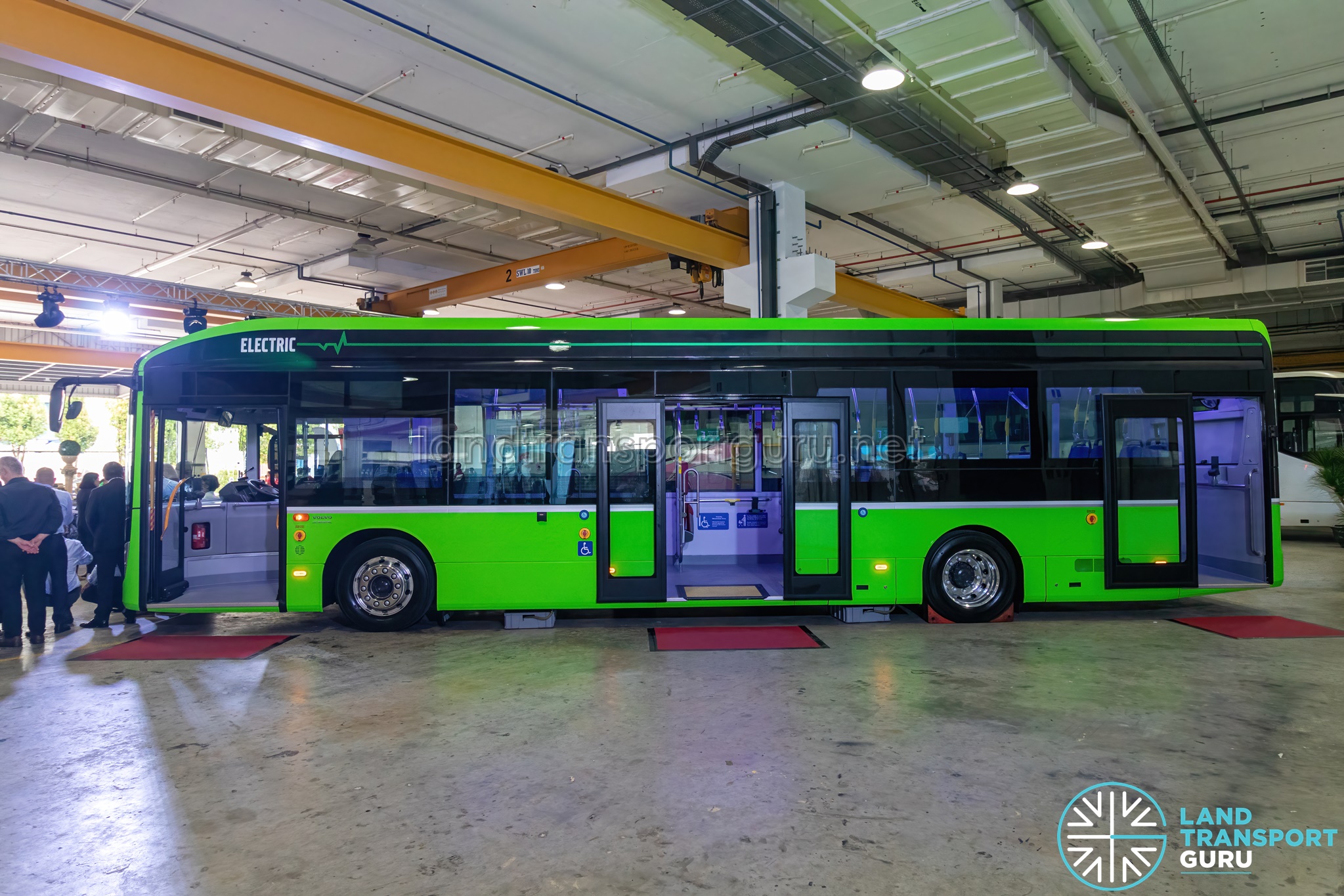



















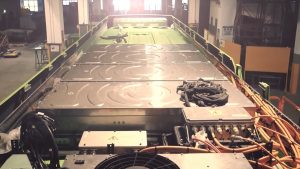









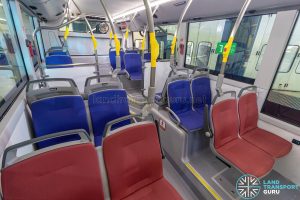
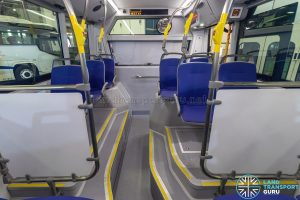


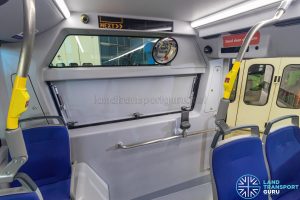






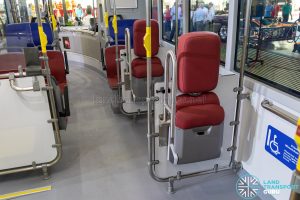



















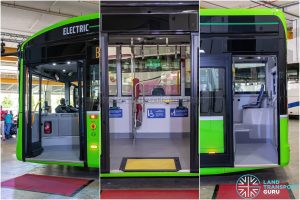







Does anyone know which shift does the SC Neustar City do on Saturdays? Thanks!
I hope this bus goes to 858 or 969
Me too!
Sorry! It is on 990
gets deploy to BUDEP to use NARI charger
It might also get deployed to MDDEP, but it parks at Bulim Depot for charging with NARI like the BYD C6.
No. It already confirms in Bulim
Oh. I saw a picture of it with Tower Transit Logos departing Clementi Interchange. Clementi has Bulim services.
https://www.facebook.com/photo?fbid=617764543496085&set=a.243563760916167
Correct!
“Based at Tower Transit’s Bulim Bus Depot, the bus is recharged via a 90 kW DC plug-in charger (CCS Type 2) originally installed for Yutong electric buses under an earlier LTA procurement for 60 electric buses. These chargers are supplied by Chinese electric power equipment supplier NARI. The Volvo BZL is rated for up to 150 kW of DC charging.”
Let’s hope it gets deploy to MDDEP services, so that I can catch it!
Correction: It is now at Bukit Batok
Volvo BZL – SC Neustar City – Rear offside view
Look at this photo
You can see the SBST give way to buses sign
Tower Transit has SBST give way sign.
Now they changed it to their own give way sign.
Tower Transit also uses the SBST give way sign.